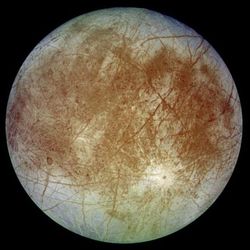Here are a few arguments in favour of this hypothesis:
- The nature of the icy ocean was confirmed by spectral analysis, it is ice water.
- The surface is cracked in places, with dark strips, invoking an ice floe covering a liquid ocean
- The craters give the impression that the water melted in an impact and solidified later to create smooth fields
- the existence of a magnetic field shows the possible presence of salty liquid water.
The presence of liquid water is also explained by the
dissipation of tides.
The crests are made of pure ice water and are several hundred meters high
separated by a few km. The surface of Europa is also renewed by the extension of these fractures
so old and new terrain coexist like on
Ganymede
The fractures come from ice, rising from within that then freezes in places where the crust has cracked due to tidal forces (they are therefore cycloidal in shape):
image 6)
or because of indirect tides that create volcanoes and geysers under the surface.
These geysers make the surface more fragile. These fractures can also be created by meteorites impacting the satellite.
The surface of Europa is relatively young and few craters are visible. On
image 1,
we can see a shiny spot which is the most recent crater, 50 km wide. On
image 3,
the oldest crater is visible at 140 km wide. The shape of the basin invokes shattered panes of glass.
In some areas, the crust is broken into pieces 10 km across that are deviated relative to each other
(image 2).
This kind of surface is similar in many ways to Earth's ice floes in spring.
Internal structure and composition:
The density of Europa is 3.014 times that of water; it can be deduced that 20 % of its volume is comprised of liquid and/or ice water,
a layer 80 to 170 km in area. The internal ocean, if it exists, is therefore in contact with a
silicate coat or an other layer of ice.
Europa has a metallic layer of iron and sulphurous iron, with a radius which is 30 à 50 % of the radius of the whole satellite.
The core is surrounded by a coat of silicates which is itself surrounded by a layer of ice/liquid water.
(image 4).
